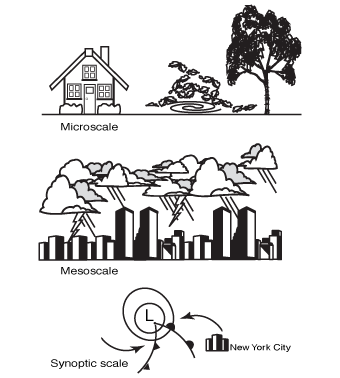Weather: Scales of Motion
Scales of Motion
In the study of atmospheric motions, little swirls are observed to feed on bigger swirls, which feed on, or spin off, even larger ones. This swirling feeding frenzy is just part of our daily weather. Splitting the atmosphere into its many spinning components really helps us understand what's going on. These scales of motion start from the smallest circulation blowing through a pile of leaves to the largest circulation extending from one end of the globe to another. Each is distinguished by its size and structure, and each generates different forms of weather, depending on—you guessed it—its vertical velocity. The following figure shows the spectrum of atmospheric motions, along with the different characteristic forms of weather.
Weather-Speak
Because the earth is rotating, the atmosphere also rotates and creates circulations of different sizes. Circulation is simply the atmosphere moving in a closed path.
All the circulations we experience can be grouped into these different categories:
- Microscale
- Synoptic
- Mesoscale
- Global
The small, microscale circulations, or eddies, don't really do much to our weather, but a somewhat stronger sea breeze can make a big difference on a summer's day. A sea breeze develops when the land areas become warmer than the ocean surface. The land heats up more than the ocean on a summer day because of the mixing that constantly occurs in the water. The surface of the water may heat up, but the mixing prevents the ocean surface from being warmer than the land. The warm air over the land is more buoyant and rises. So low pressure develops over the land, and relatively high pressure occurs over the water. The air flows from high to low pressure, from cooler sea to warmer land, and that's a sea breeze.

Scales of motion.
At night, the land areas lose their heat more effectively than the well-mixed ocean surfaces, so the opposite circulation develops and becomes a land breeze. The wind blows from land to sea. The land breeze is usually much weaker than the sea breeze, but it can be a source for mosquitoes, which drift toward the shore. They are poised and ready to crash any beach party. The figure at the bottom of the page shows the sea- and land-breeze circulations. Another example of a microscale circulation is a mountain breeze. Again unequal heating is responsible for the flow.
The next category is called synoptic from the Greek meaning "at the same time." Within that scale, observations are taken at the same time around the world and put together on a weather map for analysis. The synoptic scale is sometimes referred to as the medium scale.

Sea and land breezes.

Excerpted from The Complete Idiot's Guide to Weather © 2002 by Mel Goldstein, Ph.D.. All rights reserved including the right of reproduction in whole or in part in any form. Used by arrangement with Alpha Books, a member of Penguin Group (USA) Inc.







